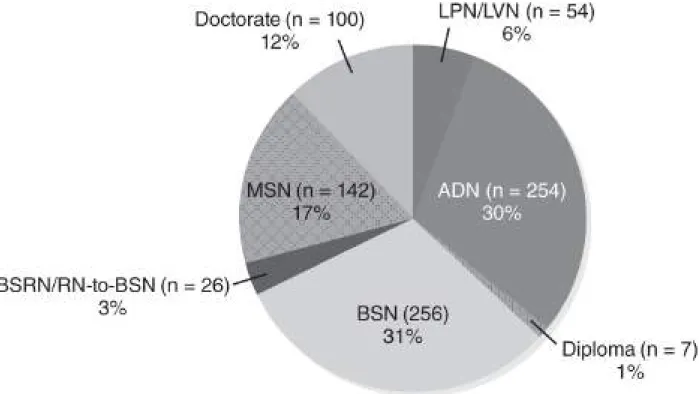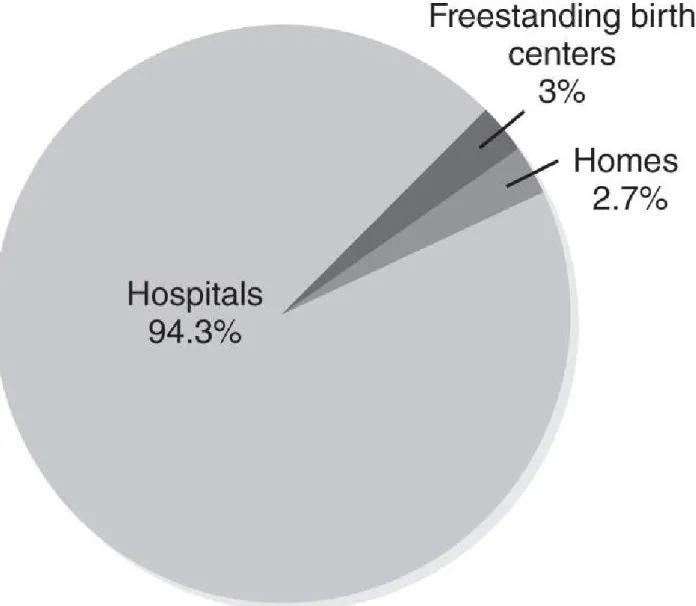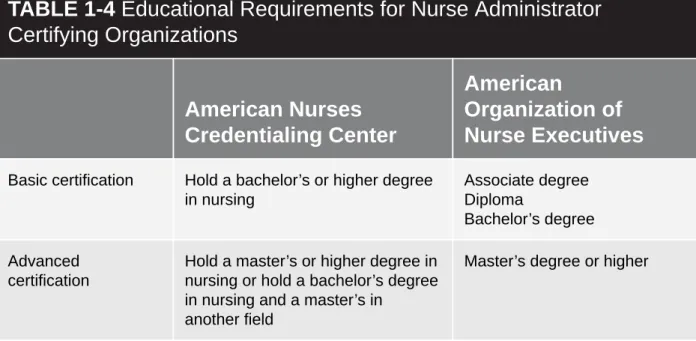The content, statements, views and opinions herein are the sole expression of the respective authors and not those of Jones & Bartlett Learning, LLC. Essential Knowledge for the Profession, Fourth Edition is an independent publication and is not authorized, sponsored, or otherwise endorsed by the owners of the trademarks or service marks referenced in this product.
Introduction
As previously mentioned, some confusion exists regarding the terminology advanced nursing practice versus advanced practice. A consensus model for regulations for advanced practice nurses was developed through work by the Advanced Practice Registered Nurse Consensus Group (2008) and the National Council of State Boards of Nursing (NCSBN).
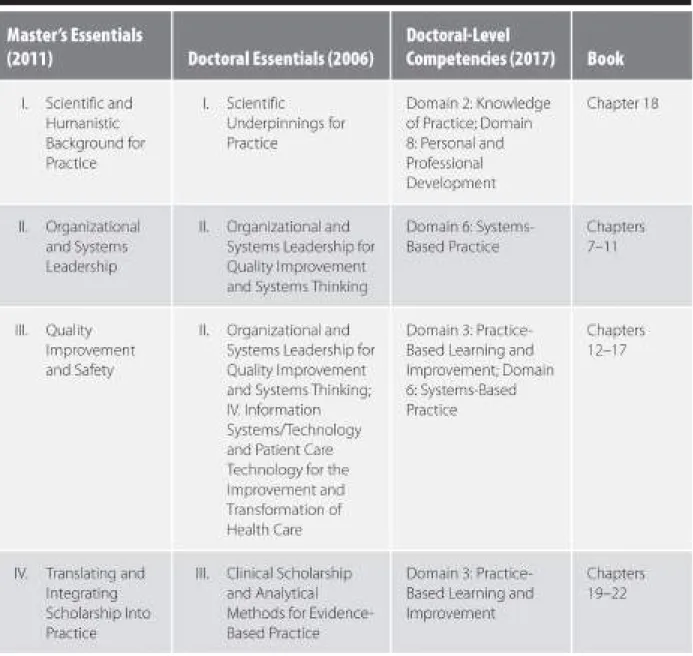
About the Author
She is the recipient of numerous state and national awards, including the American Academy of Nurse Practitioners Connecticut State Award for Excellence, National Nursing Center Consortium Primary Care. Champion Award, Connecticut Nurses Association Josephine Dolan Diamond Jubilee Award for Outstanding Contributions to Nursing.
Contributors
Pechacek, DNP, RN, CENP Clinical Associate Professor og Director Doctor of Nursing Practice (DNP) Program Senior Quality Scholar. Zaccagnini, DNP, APRN, ACNS-BC klinisk assisterende professor ad Honorem University of Minnesota, School of Nursing Minneapolis, Minnesota.
Professional Roles for Advanced Practice
The next three chapters in Part 1 discuss the future of advanced practice nursing and the evolution of doctoral education—particularly the practice doctorate. In Chapter 5, Barker lays the foundation for advanced practice nurses to recognize and embrace their roles as leaders and influencers.
Advanced practice nurse leaders trained at both the master's and doctoral level are uniquely positioned to overcome the workforce and regulatory issues that otherwise face the.
Introduction to the Role of Advanced Practice Nursing
CHAPTER OBJECTIVES
There is considerable confusion regarding the terminology advanced nursing practice, advanced practice nurse practitioner, and advanced practice nurse practitioner. Advanced practice registered nurses are licensed independent practitioners who are expected to perform in accordance with standards established or recognized by a licensing authority.
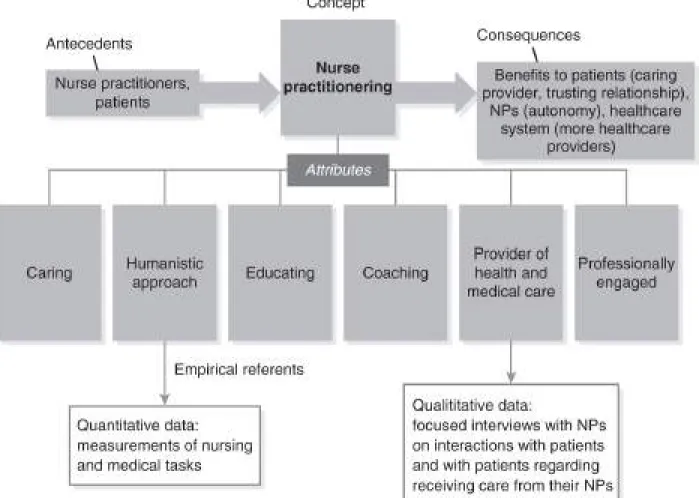
Other Advanced Practice Nursing Roles and the Nursing Curriculum
Clinical Nurse Leaders
In 2013, the CNL Expert Panel developed Competencies and Curricular Expectations for Clinical Nurse Leader Education and Practice to review the competencies in the original white paper and strengthen the original curriculum framework and practice expectations to reflect. The CNL brings evidence-based practice to the bedside, creates a culture of safety, and provides high-quality care.
Clinical Nurse Specialists
Facilitates collaborative, interprofessional approaches and strategies in designing, coordinating, and evaluating patient-centered care. NACNS (2019) reports that in the past decade, eight states have granted clinical nurse specialists the authority to practice without a physician.
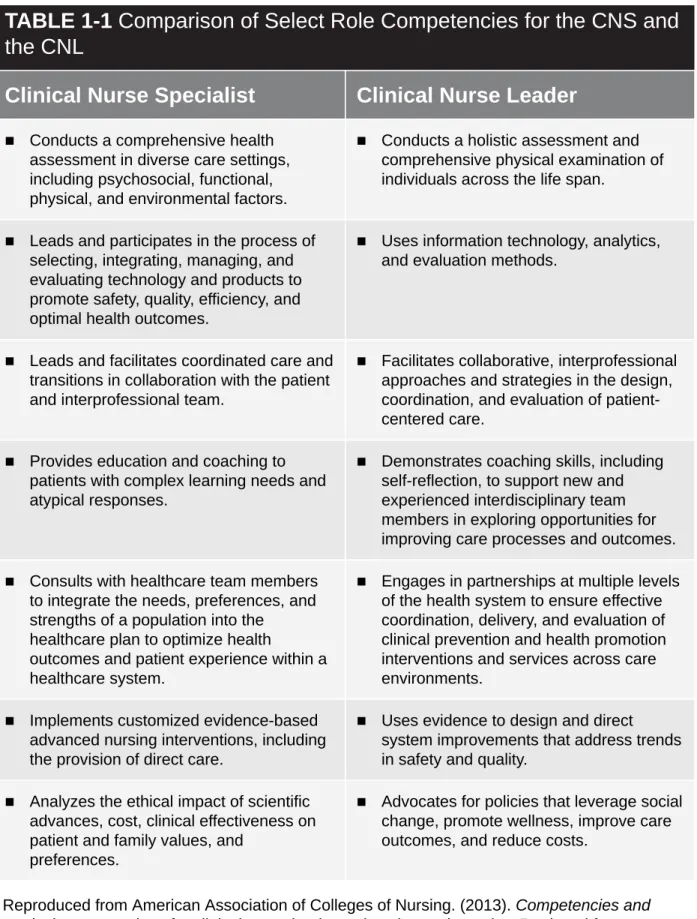
Nurse Educators
According to AACN (2014), the master's degree curriculum for nurse educators builds on baccalaureate knowledge and graduate-level content in the areas of health assessment. In this model, students are required to take courses that go beyond the core graduate curriculum and provide substantive expertise in the “3 Ps” (pharmacology, pathophysiology, and physical assessment), similar to the education of nurses and clinical nurse managers.
Supply and Demand for Nurses
Consequently, a major expansion of nursing faculty and other educational resources is needed to increase the supply. The shortage of nursing faculty contributes to the problem of nursing programs turning away qualified applicants to graduate and undergraduate programs.
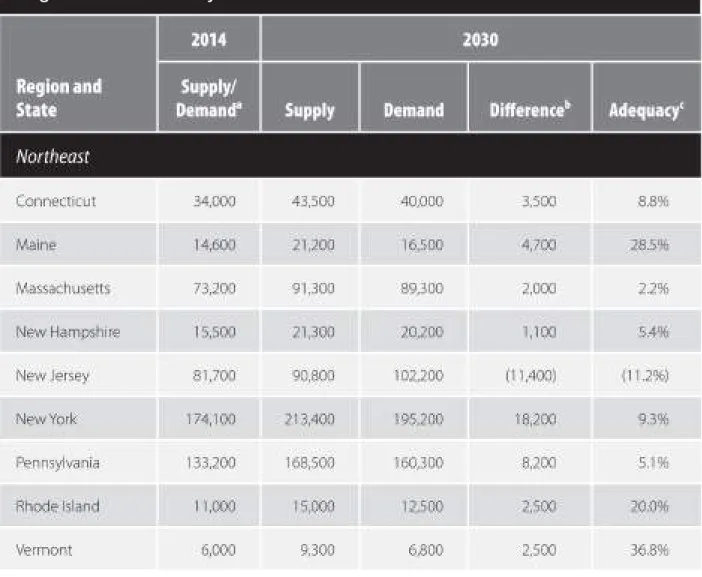
Nurse Practitioners
This analysis and recommendation coincided with the passage of legislation for the Patient Protection and Affordable Care Act of 2010, which is estimated to increase the need for qualified primary care providers to 241,200 by 2020. This, coupled with a demographically aging and ethnically diverse population, is driving demand for primary care providers – especially nurses.
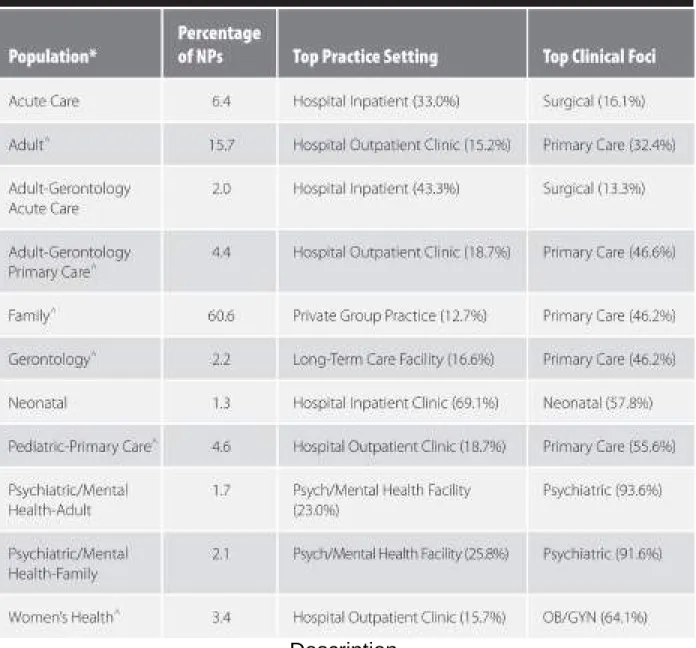
Nurse–Midwives
There are multiple entry routes into midwifery training, but most nurse-midwives graduate at the master's level, and several programs culminate in the DNP degree. Midwifery practice, as performed by certified nurses and certified midwives (CMs), is the autonomous primary care management of women's health, focusing on pregnancy, childbirth, the postpartum period, newborn care, family planning, and women's gynecological needs.
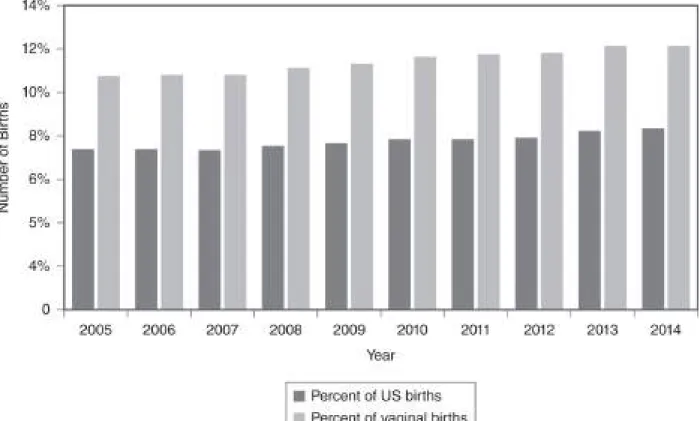
Nurse Anesthetists
Nurse Administrators
There are two organizations that certify nurse administrators: the American Nurses Credentialing Center and the American Organization of Nurse Executives. Poor orientation/on-the-job training for new nurse administrators No advanced degree requirements for the position.
Conclusion
Discussion Questions
Retrieved from http://www.nln.org/docs/default-source/about/archived-position-statements/the-preparation-of-nurse-educators-pdf.pdf. Retrieved from http://www.nln.org/docs/default-source/about/archived-position-statements/nursingedresearch_051807.pdf?sfvrsn=6.
Historical Perspectives: The Art and Science of Nurse
Practitionering
Nurses provide a solution to some of the issues affecting healthcare in America today. Seminar discussions on pertinent issues should be part of the education of student NPs and included in the discussion among those already in practice.
Historical Perspective
Nurse Practitioner Education and Title Clarification
Who has acquired advanced clinical knowledge and skills that prepare him or her to provide direct care to patients, as well as some element of indirect care; however, the defining factor for all APRNs is that a major component of education and practice focuses on the direct care of individuals; Who has obtained a license to practice as an APRN in one of four APRN roles: certified registered nurse anesthetist (CRNA), certified nurse-midwife (CNM), clinical nurse specialist (CNS), or certified nurse practitioner (CNP).1 .
The Master’s Essentials
Nurse Practitioner Core Competencies
Scientific Foundation Competencies
Leadership Competencies
Quality Competencies
Practice Inquiry Competencies
Technology and Information Literacy Competencies
Contributes to the design of clinical information systems that promote safe, high-quality, and cost-effective care.
Policy Competencies
Health Delivery System Competencies
It enables the development of health care systems that address the needs of culturally diverse populations, providers, and other stakeholders.
Ethics Competencies
Independent Practice Competencies
Develops strategies to prevent own personal biases from interfering with the delivery of high-quality care.
Doctor of Nursing Program (DNP)
There are currently 303 DNP programs enrolling students in the United States, and there are at least another 124 DNP programs in development (AACN, 2017). At this time, there are differences in the existing programs, especially as they relate to the scholarship of the terminal project, the title of which in itself has sparked many passionate debates among leaders in doctoral-level nursing education.
DNP Essentials
The AACN published The Essentials of Doctoral Education for Advanced Nursing Practice (2006) to shape DNP education to meet quality indicator criteria. Current Issues and Clarifying Recommendations – which describes and clarifies the “features of the DNP graduate fellowship, the DNP project, efficient use of resources, program duration and curriculum.
Advanced Practice Nursing Focus
In addition to direct care, DNP candidates who emphasize the care of individuals should be able to use their understanding of the practice context to document practice trends, identify potential systemic changes, and make improvements in the care of their particular patient populations within those systems , in which they practice (AACN, 2006, p. 18). The National Organization of Nurse Practitioner Faculties provides additional clarification related to competencies for NP trained to the DNP level (NONPF, 2006).
Nurse Practitioners’ Approach to Patient Care
STEPHANIE’S STORY
Through their lack of professionalism, they made it clear that I was not an important patient and that they were skeptical of my condition. Unable to make a full assessment of my diet on the spot, I told him I didn't think so.
What Nurse Practitioners Do
It has been limited to mean little more than the administration of medicine and the application of poultices. It must mean the proper use of fresh air, light, warmth, cleanliness, quietness, and the proper selection and administration of diet—all with the least expenditure of vital power on the patient.
Nursing Theories for Nurse Practitioners
The emphasis is on patient care for both methods of patient interaction. By frequently eliciting patient input, it is easier to develop mutual understanding and to develop interventions and goals to achieve a state of optimal health.
Nurse Practitioners’ Unique Role
Only a few journals wrote about the concept of the nurse as a unique phenomenon. Most of the key phrases and expressions in this pilot study confirm that the core of the nurse's work is based on the nursing care model.

Authentic Listening
In an effort to expand the key phrases, invitations to participate in interviews to share their perceptions of nursing practice were sent to 150 NPs in Connecticut. A total of 14 individual interviews were conducted with a random sample of experienced NPs who agreed to participate and share their perceptions.
Empathy
It is probably an example of advocating and coordinating and knowing that many people do not have transport. Maybe we'll enable them by doing it for them, but we'll take the extra time and, you know, ask, “What's the best day for you to go for that ultrasound.
Negotiating
Part of when I see people, I don't want to be paternalistic and tell them you have to do this, this and that. She's just a registered nurse, just out of school, and I said, “Let's talk about this new thing that's coming.
Going Above and Beyond
She built on this general practitioner –. The NP helped the patient realize his control over his health commitment and his role in his health outcome. What was the purpose of the original role of the nurse and does it differ from the role of the nurse today.
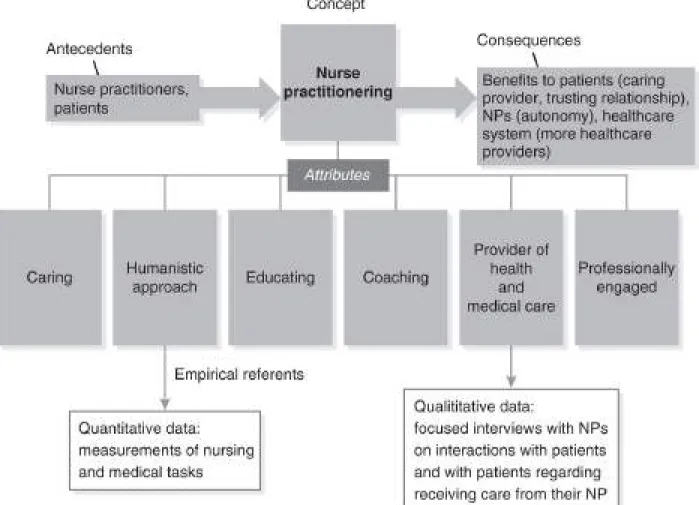
Overview of the Doctor of Nursing Practice Degree
The need for equity among the health care team, the Institute of Medicine's call for safer health care practices, and the need for increased preparation of advanced practice registered nurses to meet the changing demands of health care are all factors contributing to practice development. This chapter provides a definition of the DNP degree and a discussion of the development of doctoral education in nursing.
Doctor of Nursing Practice Degree Defined
Research-Focused Doctorate and Practice-Focused Doctorate Defined
The American Association of Colleges of Nursing Task Force on Implementation of the DNP Degree further expanded the distinction between research-focused and practice-focused scholarship in their report. This task force specified that "graduates from both research- and practice-focused PhD programs are prepared to generate new knowledge" (AACN, 2015, p. 2).
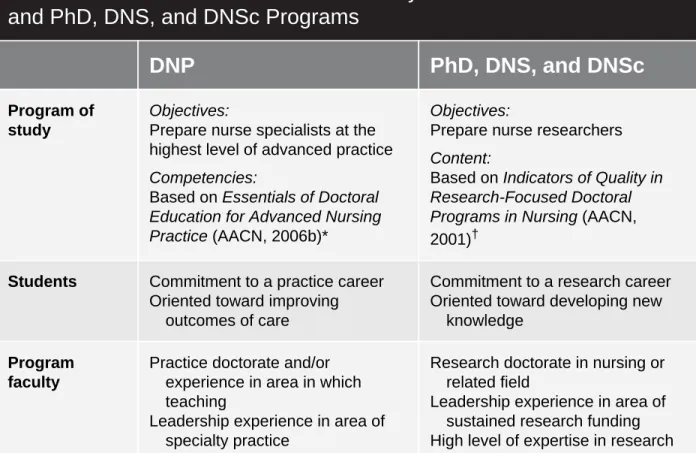
Evolution of Doctoral Education in Nursing
This phase also supported the growth of the substantive structure of nursing, hence the growth of the nursing discipline. This panel responded to the draft AACN position statement on the practice doctorate in nursing.
Why a Practice Doctorate in Nursing Now?
The Institute of Medicine’s Report and Nursing’s Response
In 2003, the Committee on Health Professions Education responded to the IOM report Crossing the Quality Chasm (2001) by publishing Health Professions Education: A Bridge to Quality (Greiner & Knebel, 2003). The IOM included recommendations in the report that specifically address the number of nurses with doctoral degrees.
Additional Drivers for a Practice Doctorate in Nursing
For disciplines such as audiology, dentistry, medicine, pharmacy, psychology and physiotherapy, a practice doctorate is required to enter practice. The development of a practice doctorate will help meet clinical education needs in schools of nursing.
What Is a DNP Degree Made Of? The Recipe for Curriculum Standards
AACN Essentials of Doctoral Education for Advanced Nursing Practice
Scientific Underpinnings for Practice
The processes by which positive changes in health status are effected. The totality of human health, recognizing that they are in continuous interaction with their environment. The science of nursing has expanded the discipline of nursing to include the development of middle-class nursing theories and concepts to guide practice.
Organizational and Systems Leadership for Quality Improvement and
Integrates nursing with knowledge from the organizational, biophysical, psychological and analytical sciences, as well as ethics, as the basis for the highest level of nursing practice. Develop and evaluate new practice approaches based on nursing theories and theories from other disciplines.
Clinical Scholarship and Analytical Methods for Evidence-Based Practice
Ensure accountability for the safety and quality of care for the patients they care for. Use informatics and research methodologies to collect and analyze data, design databases, interpret findings to design evidence-based interventions, evaluate outcomes and identify gaps within evidence-based practice, which will improve the practice environment.
Information Systems/Technology and Patient-Care Technology for the
Improvement and Transformation of Health Care
Healthcare Policy for Advocacy in Health Care
Interprofessional Collaboration for Improving Patient and Population Health
Outcomes
Clinical Prevention and Population Health for Improving the Nation’s Health
The further preparation included in the DNP curriculum will enable graduates to “epidemiological, biostatistical,.
Advanced Nursing Practice
A Note About Specialty-Focused Competencies According to the AACN
NONPF Practice Doctorate Nurse Practitioner Entry-Level Competencies
Assesses how organizational, structural, financial, marketing, and political decisions affect the cost, quality, and accessibility of health care. Uses clinical investigative skills to evaluate health outcomes at the patient, family, population, clinical unit, systems, or community level.
NACNS Core Practice Doctorate Clinical Nurse Specialist Competencies
Certified Registered Nurse Anesthetists
In 2005, the American Association of Nurse Anesthetists (AANA) convened the Summit on Doctoral Preparation for Nurse Anesthetists to discuss and identify potential implications of adopting doctoral preparation (Martin-Sheridan, Ouellette, & Horton, 2006). A recent development in terms of CRNAs earning doctoral degrees is the Doctorate of Nurse Anesthesia Practice (DNAP) degree (TheCRNA.com, 2017).
The Path to the DNP Degree: Follow the Academic Road
Many CRNA programs are offered through nursing schools, so the DNP degree is awarded through these programs. In addition, as already mentioned, the specialization content included in the DNP study program is currently fulfilled within the framework of the Master's study program.
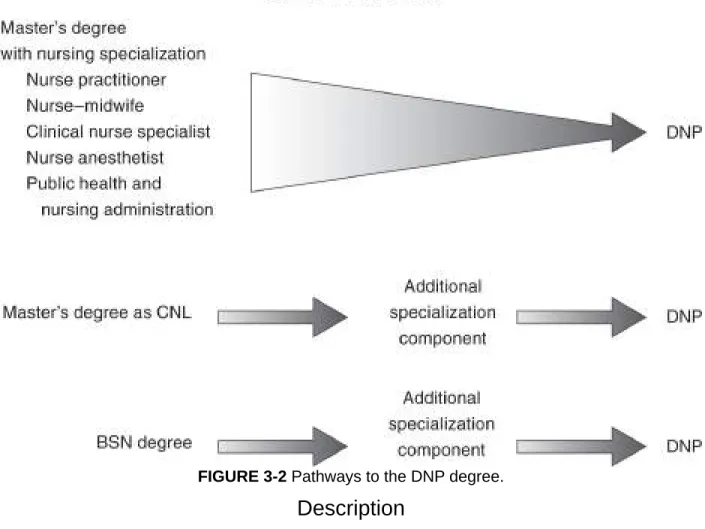
Role Transition Introduced
INTERVIEW WITH A DNP COFOUNDER: THEN AND NOW
The program in the School of Nursing was one of the first six federally funded family nurse practitioner programs in the country. I remained at Chapel Hill for 13 years before accepting a position as dean of the College of Nursing at the University of Kentucky.
Summary
Retrieved from http://www.nationalacademies.org/hmd/~/media/Files/Report%20Files/2010/The-Future-of- Nursing/Nursing%20Education%202010%20Brief.pdf. Retrieved from http://www.nationalacademies.org/hmd/Reports/2010/The-Future-of-Nursing-Leading-Change-Advancing-Health.aspx.
Emerging Roles for the DNP
Chapter Objectives
NURSE EDUCATOR
Courses in the nursing program are taught by faculty with graduate-level academic preparation and advanced expertise in the content areas they teach. It is clear that the DNP curriculum is insufficient to support the DNP-prepared nurse in the role of nurse educator.
Faculty Development Programs
Nursing Education Practicum
Graduate Teaching Assistant
New Nurse Educator Mentoring Programs
Online Learning
This support structure demonstrated an increase in the teacher's understanding of clinical teaching.
Peer Review
Retrieved from www.aacnnursing.org/News-Information/Fact-Sheets/Nursing-Faculty-Shortage Blauvelt, M., Erickson, C., Davenport, N., & Spath, M. Retrieved from www.nln.org/professional -development programmes/competencies-for-nursing-education/nurse-educator-core competence.
NURSE ADMINISTRATOR
Future job opportunities for DNP-prepared administrators will be in leadership positions in clinical practice, such as nurse managers, directors of nursing, and chief operating nurses.
Change Theory
This requires a demonstration that the change actually works and fits within the organization's values (Kotter, 1996). A literature review to find the right assessment tool for each project can be time-consuming.
Leadership Style
Developing and maintaining trust between administrators and healthcare workers is critical in creating a safe environment for patient care in the future. As a manager, it is important to be aware of the relationships between employees and be.
Evidence-Based Management Practices
Collaboration
The challenge for the administrator is to integrate this academic preparation and lifelong learning. Thinking outside the box, exploring technologies that allow for greater efficiency, and embracing new ideas while consistently paying attention to patient safety, patient and staff satisfaction, and cost will promote both better patient care and the role of DNP-prepared administrators.
PUBLIC HEALTH NURSE
Public Health Nurse: A Definition
This definition demonstrates the broad scope of practice and interprofessional nature of public health work. The ability to establish and maintain caring relationships is one of the cornerstones of public health nursing, as identified by the Minnesota Department of Health (2007).
History of Public Health Nursing
All of these examples addressed individual needs, yet interventions aimed at systems or community levels to influence programs and develop policies. Lillian Wald was a reformer of her time who greatly influenced public health nursing as it is practiced today (Jewish Women's Archive, 2019).
Foundational Principles of Public Health Nursing
Policy Development: Providing leadership in the development of health-related policies using scientific knowledge. Specific to public nursing practice, the intervention wheel is a model that identifies specific PHN interventions that support work toward these core functions and 10 essential services (Keller & . Strohschein, 2012).
Public Health Nursing National Organizational Framework
The National Advisory Council on Nursing Education and Practice (NACNEP, 2014) identifies a need for advanced practice registered nurse (APRN) roles in public health nursing. Practicum and Master of Public Health (DNP/MPH) and Doctor of Philosophy in Nursing with an emphasis in public health.
National Public Health Performance Standards Program
